- Joined
- Feb 2, 2011
- Messages
- 2,093
NEW RELEASES FOR APRIL 2022
THE AGE OF ARTHUR
THE VIKINGS
THE VIKING DRAGON (DREKI) LONGSHIP
When Magnus the Good (1047) put his ships to sea, it was as if a swarm of angels from the King of heaven – soared over the waves. (The skald Arnorr)
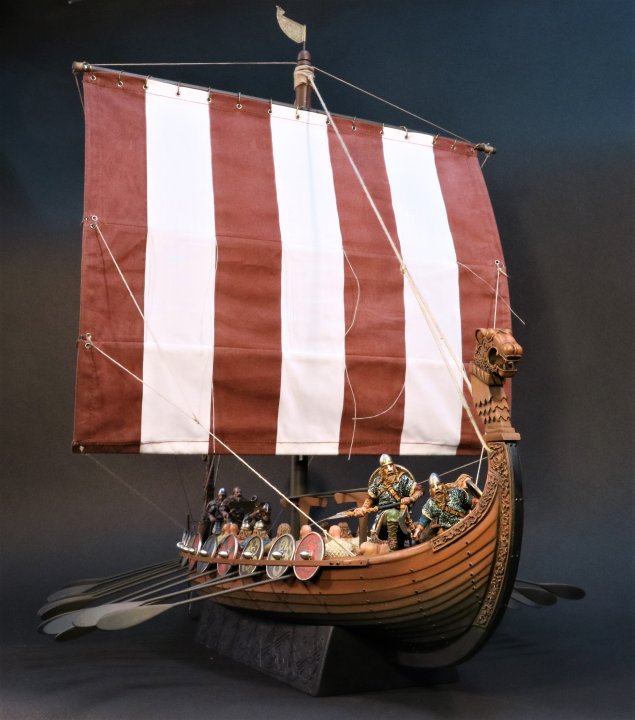
LONGSHIP
THE AGE OF ARTHUR,
VIKING DRAGON (DREKI) LONGSHIP,
(75pcs)
LONGSHIP Dimensions 59cm length x 35cm wide (includes oars) x 48cm height
LONGSHIP Dimensions 23 ¼” length x 13 ¾” wide (includes oars) x 19” height
THE LONGSHIP SET CONTAINS
20 CREW ROWING,
6 VIKING WARRIORS.
20 Shields
23 Oars
SHIPPING BOX DIMENSIONS 67cm length x 38cm wide x 9cm height
26 ½” length x 15” wide x 7 ½” height
WEIGHT 5.59kg
PLEASE NOTE THIS ITEM IS NOW SOLD OUT
Without the Viking ships, there would be no Viking Age. Norse sagas, skaldic poems and contemporary foreign sources describe the Viking ships as marvelous at sea:
The Vikings sailed over vast distances with these ships, from America in the west to Asia Minor in the east, and perhaps even farther.
It was the seaworthiness of the Viking ships, together with the Norsemen’s knowledge of navigation and seamanship, which made it possible for them to conquer the ocean. The Vikings’ understanding of the sea is also reflected in the Old Norse language that has about 150 words for waves.
During the Viking Age (900-1200 AD) Vikings were the dominant seafarers of the North Atlantic. One of the keys to their success was the ability to navigate skillfully across the open waters. The Vikings were experts in judging speed and wind direction, and in knowing the current and when to expect high and low tides.
Viking navigational techniques are not well understood, but historians postulate that the Vikings probably had some sort of primitive astrolabe and used the stars to plot their course.
Longships were a type of specialized Scandinavian warship, documented from at least the fourth Century BC. Originally developed and designed by the Norsemen (Vikings) for commerce, exploration, and warfare. Many of the Longship’s characteristics were adopted by other cultures, such as the Anglo-Saxons, and continued to influence shipbuilding for centuries.
The Longship’s designs evolved over many centuries, and continuing up until the 6[SUP]th[/SUP] century with clinker built ships like Nydam and Kvalsund. The longship appeared in its complete form between the 9[SUP]th[/SUP] and 13[SUP]th[/SUP] Centuries. The character and appearance of these ships have been reflected in Scandinavian boat-building traditions to the present day.
The particular skills and methods employed in making longships are still used worldwide, often with modern adaptations.
They were all made out of wood, with cloth sails (woven wool) and had several details and carvings on the hull.
The Longships were characterized as graceful, long, narrow and light, with a shallow draft hull designed for speed. The ships’s shallow draft allowed navigation in waters only one meter deep and permitted arbitrary beach landings, whilst its light weight enabled it to be carried over portages or used bottom up for shelter in camps
Longships were also double ended, the symmetrical bow and stern allowing the ship to reverse direction quickly without a turn around. This trait proved particularly useful at northern latitudes, where icebergs and sea ice posed hazards to navigation.
Longships were fitted with oars along almost the entire length of the boat itself. Later versions had a rectangular sail on a single mast, which was used to replace or augment the effort of the rowers, particularly during long journeys.
The average speed of Viking ships varied from ship to ship, but lay in the range of 5-10 knots (9-18 km/h) and the maximum speed of a longship under favourable conditions was around 15 knots (28km/h)
THE AGE OF ARTHUR
THE CRUSADES
THE ALMORAVIDS
The Almoravids, also known as the Murabits, were a fundamentalist Islamic movement of the 11[SUP]th[/SUP] and 12[SUP]th[/SUP] Centuries. Founded by Ibn Yasin, in southern Morocco, they combined devotion to Islam with a fierce military tradition, and a desire to conquer. In 1070, the Almoravids established their capital city at Marrakesh, which at the time, was little more than a mosque in the desert surrounded by the tents of the faithful.
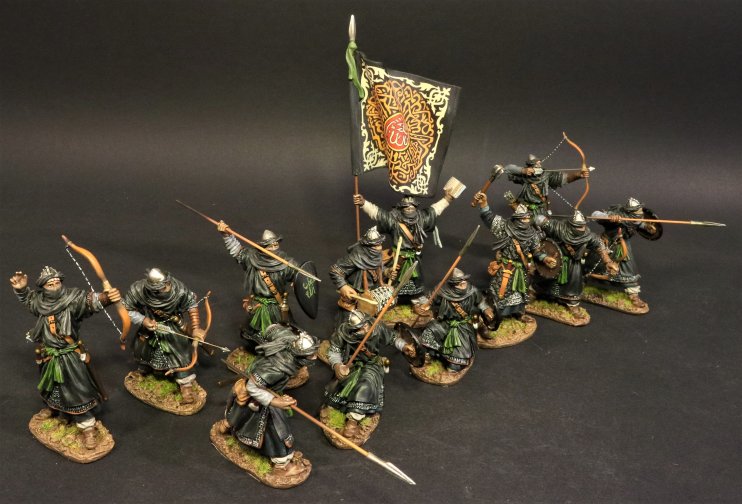
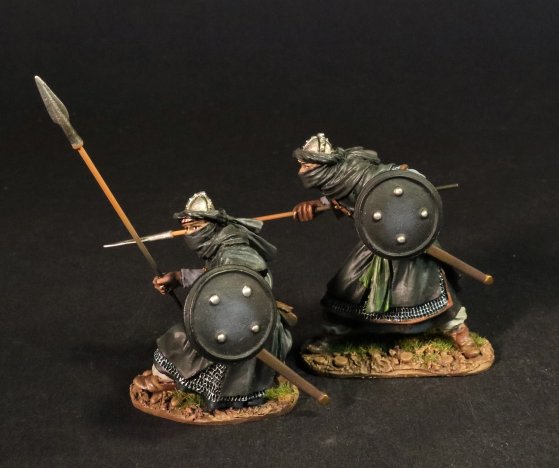
ALM-18A
THE CRUSADES,
EL CID AND THE RECONQUISTA,
THE ALMORAVIDS,
2 SPEARMEN.
(3 pcs)
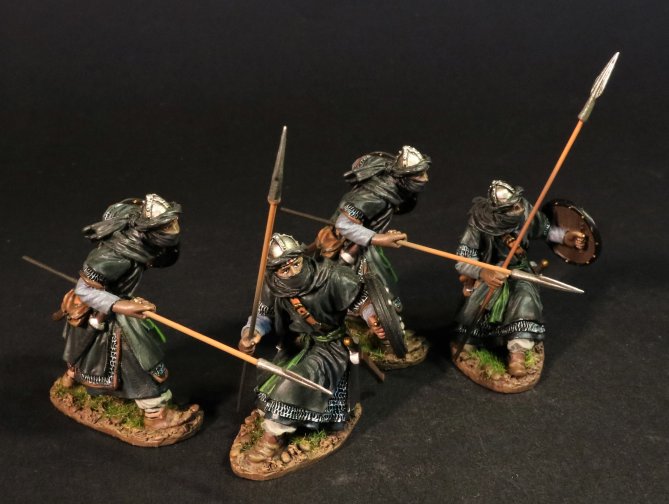
ALM-18AN
THE CRUSADES,
EL CID AND THE RECONQUISTA,
THE ALMORAVIDS,
4 SPEARMEN.
(6 pcs)
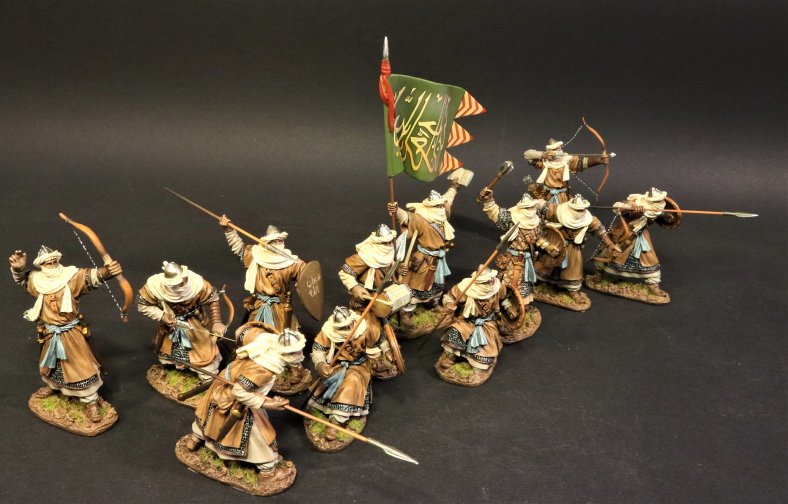
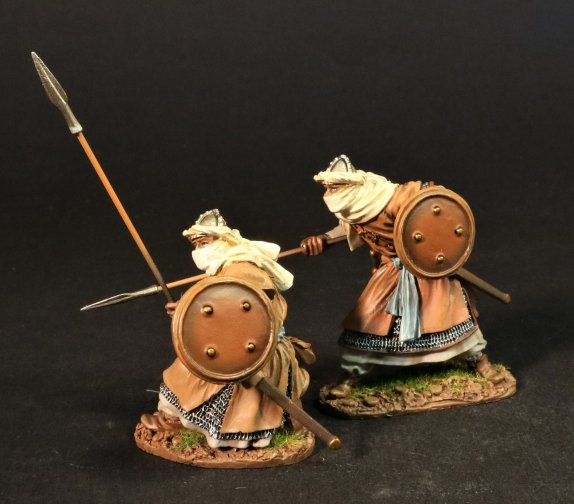
ALM-18B
THE CRUSADES,
EL CID AND THE RECONQUISTA,
THE ALMORAVIDS,
2 SPEARMEN.
(3 pcs)
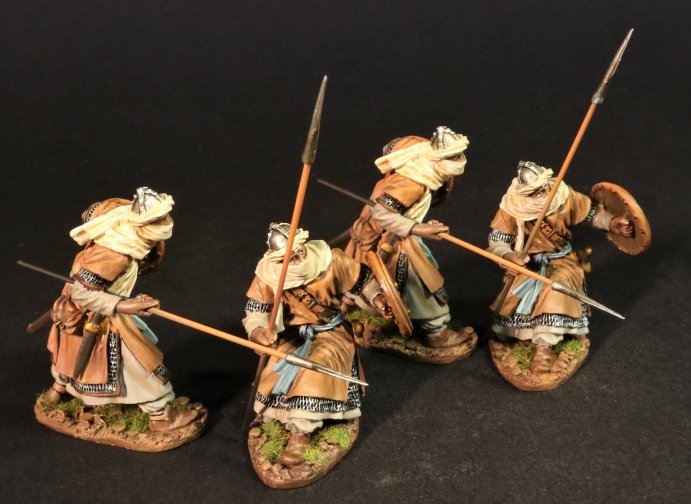
ALM-18BN
THE CRUSADES,
EL CID AND THE RECONQUISTA,
THE ALMORAVIDS,
4 SPEARMEN.
(6 pcs)
**PLEASE CONTACT YOUR LOCAL DEALER FOR FURTHER INFORMATION**
THE AGE OF ARTHUR
THE VIKINGS
THE VIKING DRAGON (DREKI) LONGSHIP
When Magnus the Good (1047) put his ships to sea, it was as if a swarm of angels from the King of heaven – soared over the waves. (The skald Arnorr)

LONGSHIP
THE AGE OF ARTHUR,
VIKING DRAGON (DREKI) LONGSHIP,
(75pcs)
LONGSHIP Dimensions 59cm length x 35cm wide (includes oars) x 48cm height
LONGSHIP Dimensions 23 ¼” length x 13 ¾” wide (includes oars) x 19” height
THE LONGSHIP SET CONTAINS
20 CREW ROWING,
6 VIKING WARRIORS.
20 Shields
23 Oars
SHIPPING BOX DIMENSIONS 67cm length x 38cm wide x 9cm height
26 ½” length x 15” wide x 7 ½” height
WEIGHT 5.59kg
PLEASE NOTE THIS ITEM IS NOW SOLD OUT
Without the Viking ships, there would be no Viking Age. Norse sagas, skaldic poems and contemporary foreign sources describe the Viking ships as marvelous at sea:
The Vikings sailed over vast distances with these ships, from America in the west to Asia Minor in the east, and perhaps even farther.
It was the seaworthiness of the Viking ships, together with the Norsemen’s knowledge of navigation and seamanship, which made it possible for them to conquer the ocean. The Vikings’ understanding of the sea is also reflected in the Old Norse language that has about 150 words for waves.
During the Viking Age (900-1200 AD) Vikings were the dominant seafarers of the North Atlantic. One of the keys to their success was the ability to navigate skillfully across the open waters. The Vikings were experts in judging speed and wind direction, and in knowing the current and when to expect high and low tides.
Viking navigational techniques are not well understood, but historians postulate that the Vikings probably had some sort of primitive astrolabe and used the stars to plot their course.
Longships were a type of specialized Scandinavian warship, documented from at least the fourth Century BC. Originally developed and designed by the Norsemen (Vikings) for commerce, exploration, and warfare. Many of the Longship’s characteristics were adopted by other cultures, such as the Anglo-Saxons, and continued to influence shipbuilding for centuries.
The Longship’s designs evolved over many centuries, and continuing up until the 6[SUP]th[/SUP] century with clinker built ships like Nydam and Kvalsund. The longship appeared in its complete form between the 9[SUP]th[/SUP] and 13[SUP]th[/SUP] Centuries. The character and appearance of these ships have been reflected in Scandinavian boat-building traditions to the present day.
The particular skills and methods employed in making longships are still used worldwide, often with modern adaptations.
They were all made out of wood, with cloth sails (woven wool) and had several details and carvings on the hull.
The Longships were characterized as graceful, long, narrow and light, with a shallow draft hull designed for speed. The ships’s shallow draft allowed navigation in waters only one meter deep and permitted arbitrary beach landings, whilst its light weight enabled it to be carried over portages or used bottom up for shelter in camps
Longships were also double ended, the symmetrical bow and stern allowing the ship to reverse direction quickly without a turn around. This trait proved particularly useful at northern latitudes, where icebergs and sea ice posed hazards to navigation.
Longships were fitted with oars along almost the entire length of the boat itself. Later versions had a rectangular sail on a single mast, which was used to replace or augment the effort of the rowers, particularly during long journeys.
The average speed of Viking ships varied from ship to ship, but lay in the range of 5-10 knots (9-18 km/h) and the maximum speed of a longship under favourable conditions was around 15 knots (28km/h)
THE AGE OF ARTHUR
THE CRUSADES
THE ALMORAVIDS
The Almoravids, also known as the Murabits, were a fundamentalist Islamic movement of the 11[SUP]th[/SUP] and 12[SUP]th[/SUP] Centuries. Founded by Ibn Yasin, in southern Morocco, they combined devotion to Islam with a fierce military tradition, and a desire to conquer. In 1070, the Almoravids established their capital city at Marrakesh, which at the time, was little more than a mosque in the desert surrounded by the tents of the faithful.


ALM-18A
THE CRUSADES,
EL CID AND THE RECONQUISTA,
THE ALMORAVIDS,
2 SPEARMEN.
(3 pcs)

ALM-18AN
THE CRUSADES,
EL CID AND THE RECONQUISTA,
THE ALMORAVIDS,
4 SPEARMEN.
(6 pcs)


ALM-18B
THE CRUSADES,
EL CID AND THE RECONQUISTA,
THE ALMORAVIDS,
2 SPEARMEN.
(3 pcs)

ALM-18BN
THE CRUSADES,
EL CID AND THE RECONQUISTA,
THE ALMORAVIDS,
4 SPEARMEN.
(6 pcs)
**PLEASE CONTACT YOUR LOCAL DEALER FOR FURTHER INFORMATION**

